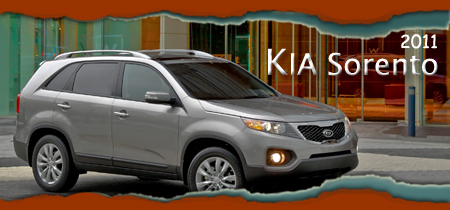
2011 Kia Sorento Car-based CUV Road Test Review
Mixing safety gear with V6 power
By Bob Plunkett
Kia, the automaker from South Korea, has invested $1 billion to construct a new manufacturing facility in the United States at West Point, Ga.
The vast complex, spread over 2,200 acres along I-85 on the Georgia-Alabama border, encompasses a car-body stamping operation, transmission factory, two-mile-long vehicle test track and the main automobile assembly plant where thousands of workers conspire to put together 2011 issues of a five-door crossover utility vehicle.
Kia's first Made-in-the-USA vehicle is called Sorento and it amounts to a car-like unibody redesign of the 2003 body-on-frame SUV named Sorento.
The 2011 Sorento CUV shows distinctive styling for the external package, a comfortable cabin with room for five or seven passengers, two powertrain choices for fuel economy or get-up-and-go zip, plus mechanical hardware which sets up a smooth-riding vehicle with optional all-wheel-drive (AWD) equipment available for sure-grip passage on slippery pavement.
Most significant difference between the original 2003 Sorento and the second-generation 2011 Sorento concerns the unibody structure.
New Sorento is constructed with an integral body-frame structure which compares to a front-wheel-drive (FWD) car rather than the original Sorento's rear-wheel-drive (RWD) body-on-frame truck platform.
The structural change essentially transforms Sorento from a truckish SUV to a car-base CUV which drives like an easy-riding sedan.
Sorento's new platform supports a 106.3-inch wheelbase and a track width of 63.7 inches up front and 63.8 inches in back. Setting the wheels out near edges of the chassis brings stability to the stance and enhances Sorento's agility when cornering.
Roll over pavement expansion creases and the independent suspension -- struts in front and a multi-link arrangement in back with a stabilizer bar at both ends tuned to check excessive lateral roll of the body -- blips the all-season tires in exacting up-down motions and makes a firm ride quality.
Crank the sport steering wheel and Sorento cuts with direct action, thanks to a rack and pinion system with conventional hydraulic power assistance.
A disc brake goes to every wheel with 11.8-inch vented front rotors and 11.9-inch solid rear rotors.
All tie by computerized links to a sophisticated anti-lock brake system (ABS) with electronic brake force distribution (EBD), plus electronic stability control (ESC) with traction control system (TCS), even hill-start assist control (HAC) and downhill brake control (DBC).
All trim versions of Sorento 2011 stock lots of passive safety systems like frontal and seat-mounted side-impact air bags for front seats and the curtain-style air bags mounted above outboard seats at all rows.
For locomotion Kia presents two aluminum-block powertrain options.
The base engine is a dual-cam 2.4-liter in-line-four plant with CVVT (continuously variable valve timing) for high-tech metering of the fuel burn.
Output reaches to 175 hp at 6000 rpm, with torque running up to 169 lb-ft at 3750 rpm.
Either a six-speed manual transmission or a new Kia-built electronically controlled six-speed automatic with Sportronic hands-on shift control goes with this engine.
The optional engine -- a 3.5-liter V6 with dual overhead cams -- generates 276 hp at 6300 rpm and 248 lb-ft of torque at 5000 rpm.
Sorento's V6 links exclusively with the six-speed Sportmatic automatic.
Both engines work with FWD traction or a permanently-engaged AWD system.
The smart AWD equipment uses a computer and wheel sensors to determine how much power to apply at each wheel for maintaining tire traction on slippery pavement.
Also, the AWD rig adds a locking center differential which distributes engine torque equally between front and rear wheels to maximize tire grip.
Kia's design for Sorento's new exterior package appears sleek and shapely, yet the scheme reflects subtle lines and subdued paint colors in the manner of sophisticated -- and expensive -- vehicles.
The slinky shape of Sorento differs from the upright style of the predecessor. It looks strong and athletic with contemporary forms and a long cabin perched above the horizontal underbody.
The vehicle's expanded width is emphasized up front by a broad grille with honeycomb mesh and narrow corner headlamp clusters.
And on each flank there's a crisp character line cut below side windows and it ties into the bulging -- muscular -- wheel arches.
Climb aboard the Sorento and you'll notice another benefit of the car-like unibody structure: Kia's designers managed to drop the cabin floor but still retain a reasonable chassis height for ground clearance. As a result, you don't have to hike up to climb aboard, but simply slip in sideways like you might enter a sedan.
On the first row two bucket seats flank a floor console. On the second row the standard bench accommodates three riders with high cushion height and generous legroom. On the third row an optional folding bench split 50/50 holds two adult passengers.
Sorento trims are labeled as Base, LX, EX and EX V6.
The base edition with manual shifter and 17-inch alloy wheels supplies cabin goods like air conditioning, power controls for windows and door locks, tilt/telescope steering wheel and an audio kit with AM/FM/CD/MP3/USB.
Sorento LX adds the automatic transmission, heated exterior mirrors and an optional convenience package with roof rails, fog lamps, parking sensors and rearview camera.
Sorento EX rolls on 18-inch alloy wheels and nets luxury gear like a keyless ignition and dual-zone climate controls plus the optional premium and limited packages with leather upholstery and voice-activated navigation system.
Kia's price chart for the 2011 Sorento looks good in a range from $19,995 to $28,895.
For more info on the Sorento, visit Kia's website.
FOR MORE ROAD TEST REVIEWS - VISIT RTM'S NEW CAR REVIEW ARCHIVE.
|